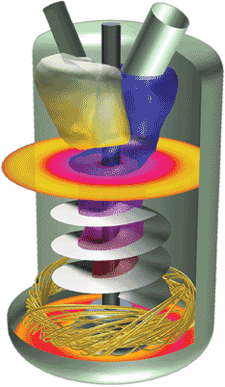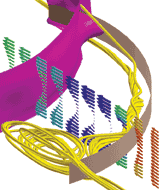Latest News
November 1, 2004
By Steve M. Legensky
In 1995, the chemical processing industry was just beginning to understand thepositive impact that computational fluid dynamics (CFD) technology could haveon the way companies design, maintain, and implement products and applications.Chemical and industrial giant Monsanto, through its Chemical Group, was one ofthe first companies to embrace CFD as an enterprise-wide resource for improvinginternal product development processes. By the time Monsanto had spun-off itsChemical Group, Solutia, Inc., the industry had fully accepted CFD’s role as avital technological tool used by companies reaching for competitive benefits.
A number of well-established, global chemical producers put comprehensive CFDoperations in place, using the latest techniques and software to make processesmore efficient, safer, and ultimately more profitable. To do this effectively,the CFD units within these companies, for the most part, relied on the latestsolvers to perform calculations based on user-entered data. These solvers, includingpopular applications like Fluent, CFX, and FLOW 3-D, are the workhorses behindachieving outstanding technical results.
But the need to achieve outstanding results continues as the chemical processingindustry increases its focus on process efficiency and bottomline results. Tougherbusiness challenges and more uncertainties appear each day, and now, more thanever, a CFD solution has to help companies address the difficulties of runningthe business; not just solve analysis problems.
Currently there are two key questions in the industry: How can results derivedfrom a solver be communicated effectively to other team members, and how can theentire enterprise benefit from the CFD group’s knowledge and experiences?
“More than ever, all of us in this industry need to have the ability to quicklyunderstand what’s happening inside our equipment,” said David Davidson, a formerdirector of CFD at Solutia, “and, based on the information we have, find a solutionthat can make it better, more efficient, and more cost-effective.”
In short, the industry needed a tool to address a CFD user’s dual role as technologicalwizard and business-minded professional.
This FLUENT simulation uses FieldView to illustrate how a helical mixer bladecombines two fluids and drives them toward the bottom of a tank where they aremixed effectively via strong recirculation.
Post Processing Software Leads the Way
One such postprocessor is FieldView. Developed and marketed by Intelligent Lightof Rutherford, New Jersey, FieldView takes data sets (large volumes of raw numbers)produced by the CFD solver and generates 2D and 3D images, which can then be organizedand manipulated by users to understand how the device they’re designing will reactwith heat, gas, or fluids. The solution works with data generated by just aboutany of today’s leading CFD solvers and presents the mathematical results in 3Dvisual representations.
Veteran CFD users in the chemical processing industry can attest to the importanceof having a powerful postprocessor on hand. These users—many of whom were consideredleading-edge pioneers just a few years ago—now sit at the forefront of this dynamicindustry, facing the technical challenge of designing or optimizing equipmentin addition to the business challenges of day-to-day operations.
The postprocessor is well-suited to help CFD users in the chemical processingarena after having proven its effectiveness in other complex design environments.For years, CFD users in industries like aerospace and automotive have used postprocessingsolutions to analyze aircraft designs, peer inside combustion engines, and performother analytical functions. As in these industries, accuracy, functionality, andflexibility are necessities in the chemical industry, where increasing complexitiesand workloads are challenging even the most veteran of CFD users.
 Christian von Törne of Bayer used this simulation to quantify the impact of achemical reaction on physical operating conditions.
Christian von Törne of Bayer used this simulation to quantify the impact of achemical reaction on physical operating conditions.
“Our work is nowhere near done when the solver gives us data,” said Davidson.“There are so many steps to accomplish when we design or optimize our equipment.A powerful postprocessor like FieldView lets us reach our goals in a very efficient,cost-effective manner. It’s that level of functionality and accuracy that’s necessaryin this business.” The business Davidson referred to is a 10,000-employee international behemothwith $3.2 billion in annual sales in a number of divisions, including nylon fiber,chemicals, and acrylic fiber. A large portion of the business involves the designand development of highly specialized equipment used for spinning fibers, mixingchemicals, or cutting and measuring materials used both in house and also soldto international customers. Solutia’s experts also work with these customers tohelp them use the equipment more efficiently, and feedback informs the company’sequipment designers as they make improvements.
The business Davidson referred to is a 10,000-employee international behemothwith $3.2 billion in annual sales in a number of divisions, including nylon fiber,chemicals, and acrylic fiber. A large portion of the business involves the designand development of highly specialized equipment used for spinning fibers, mixingchemicals, or cutting and measuring materials used both in house and also soldto international customers. Solutia’s experts also work with these customers tohelp them use the equipment more efficiently, and feedback informs the company’sequipment designers as they make improvements.
FieldView and CFX are combined to improve the baffle design in a drying apparatus.The aim was to get uniform air flow distribution in a certain area of the machinewithout undue pressure loss.
A Flexible Solution
Davidson directed a team of about eight CFD users, just two of whom were consideredexpert-level users. While the team supports the various divisions at Solutia inaddition to its consultancy work with customers, the relatively small size ofthe CFD group combined with the sheer volume of its workload means it must leverageevery advantage from its CFD tools. To accomplish this, the team maximizes featuressuch as visualization and calculation tools, its ability to handle data sets fromvarious solvers simultaneously, and its “batch mode” that allows the team to processmultiple cases, export results, and share data with other design codes to integratethe analysis process.
It’s the combination of speed and functionality that Mathijs Goldschmidt relieson in his work with Akzo Nobel, a Netherlands-based producer of chemicals, pharmaceuticals,and coatings.
Goldschmidt is responsible for applying CFD technology to support many internalbusiness groups. He and his three-person team work on many types of challenges,from improving equipment design to streamlining research and even production processes.
As a result, the team needs a postprocessor to quickly and easily help it understandhow everything—heat, liquid, gas, etc.—moves inside the process or device on whichthey are working. One of the most successful uses of the postprocessor for AkzoNobel has been its work on the bubble column reactor.
“An environment like our bubble column reactor has to be highly calibrated inorder to produce the accurate measurements that our clients require,” said Goldschmidt.“If we don’t completely understand the hydrodynamics of this controlled environment,then our clients can’t meet their goals. With FieldView, the compelling visualizationsof our data gave us the quick, comprehensive view we needed to understand thesituation.”
Value added In Numerous Ways
While quick and powerful performance is a common requirement in any chemicalprocessing company’s technology solution, many users of FieldView have echoeda familiar sentiment: its intuitiveness and ease of use are key to their CFD success.
At Solutia, the CFD team’s workload had become so large that it just wasn’t practicalto ride a learning curve of any kind. With FieldView, the team was able to implementthe postprocessor almost immediately. The ability to efficiently and quickly integrateits features into existing processes is crucial when time to market can mean thedifference between success and failure.
“This is a very competitive environment,” explains Dr. Christian von Törne, aCFD user with Bayer AG in Germany, a chemical and pharmaceutical giant, “so itis important to be able to do things quickly.” Dr. von Törne’s applications usingthe visualization program include optimizing the efficiency of his company’s processequipment. One example of a typical application requires him to find recirculationzones within reactors. For this, he uses a variety of features, including theFeature Extraction-Vortex Core tool, iso-surfaces, and cutting planes with projectedvectors. These tools help him to identify the recirculation zones within reactorsand then present the easily understood graphic results to colleagues or customersquickly and easily. “With FieldView I could start right away, without training.This is not something one would expect from such a complex tool.”
The postprocessor has become an integral component of CFD operations and beyond.It has not only provided technological benefits, but has improved and in somecases made it possible for CFD users to communicate problems, solutions, or ideas.This is an audience that might understand business, products, or services, butnot necessarily CFD.
When using this tool in live presentations with customers, Akzo Nobel’s Goldschmidtand his team can “move dynamically, so the customer can guide you to the areaof interest. This leads to a much better understanding of the process being studied,“he said. “In the past, if I had prepared a written report with pictures, I wouldinvariably miss some angle or area that the customer wanted to see. With FieldViewwe can explore the data together.”
This improved interaction is a large benefit to the CFD team. Because the solutionmakes CFD data so clear, users like Goldschmidt can spend more time talking withcustomers about the real challenges in a design; he can get to the heart of aproblem, without having to worry about the postprocessor. Presentations or projectscan be streamlined, so discussions can focus on the issues the customer caresabout most.
Intelligent Light makes such interaction and visual generation possible by equippingFieldView with advanced postprocessing features. These include Automated FeatureExtraction, Surface Streamlines (oil flow traces), Data Set Comparison, quantitativeanalysis tools, and interactive tools to create high-quality presentations andanimations.
Addressing Real Needs
In the end, features and functionality—no matter how innovative or advanced—donot benefit a company unless they help address the engineering challenges of today’schemical processing industry. These challenges include achieving efficiency inproduct development, processes, and services; effectively interacting with customersand internal management alike; and being able to make informed decisions thatcan trim the cost of doing business.
Solutia’s Davidson once summed up his perspective on CFD postprocessors witha story about a colleague at a different company who was conducting measurementand optimization work on a chemical reactor. Management at this company gave thisemployee a directive to implement a new $1 million design in order to improvethe reactor’s efficiency.
Sensing that something was amiss in the new design plans, the engineer performedsome further measurements on the reactor and collected data on its hydrodynamics.He then took the data and generated some graphics using FieldView. To his surprise—andsatisfaction—the results showed that, while the old design certainly did havesome inefficiencies, the new design was not going to solve its problems.
“He just took the still images of his data,” said Davidson, “walked into theproject meeting, and presented the visual evidence that supported his hunch thata new upgrade strategy was needed. Well, the room just went silent. There wasall the proof management needed.”
The company eventually scrapped the new design, opting instead for an alternativeplan supporting upgrades. Ultimately, the new course of action cost about 30 percentless than the redesign would have cost, and expected efficiencies were improved.“You know how they say a picture is worth a thousand words?” said Davidson. “Well,these kinds of pictures are worth a million dollars.”
Steve M. Legensky is the general manager of Intelligent Light, Inc. You can contacthim about this article via e-mail addressed to [email protected].
(Editor’s Note: The author reported with sadness that shortly after completingthis article, David Davidson of Solutia passed away.)
Product Information | ||||
CFX | FieldView | Fluent | FLOW-3D | Solutia, Inc. |
Subscribe to our FREE magazine, FREE email newsletters or both!
Latest News
About the Author
DE’s editors contribute news and new product announcements to Digital Engineering.
Press releases may be sent to them via [email protected].






